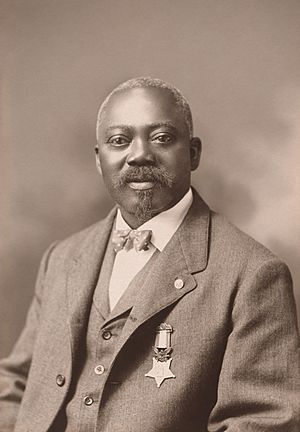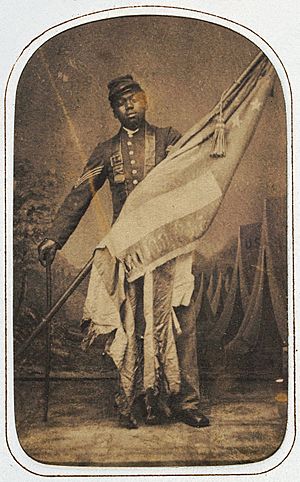William Harvey Carney facts for kids
Quick facts for kids
William Harvey Carney
|
|
|---|---|

Carney, wearing the Medal of Honor he received in 1900.
|
|
| Born | February 29, 1840 Norfolk, Virginia, U.S. |
| Died | December 9, 1908 (aged 68) New Bedford, Massachusetts, U.S. |
| Place of burial |
Oak Grove Cemetery, New Bedford, Massachusetts, U.S.
|
| Allegiance | United States (Union) |
| Service/ |
U.S. Army (Union Army) |
| Years of service | 1863–1864 |
| Rank | Sergeant |
| Unit | |
| Battles/wars | American Civil War |
| Awards | Medal of Honor |
William Harvey Carney (born February 29, 1840 – died December 9, 1908) was a brave American soldier. He fought during the American Civil War. William Carney was born into slavery. He later earned the Medal of Honor for his amazing courage. This medal is the highest award for bravery in the U.S. military.
Carney received the medal in 1900. He earned it for saving his regiment's flag during the Battle of Fort Wagner in 1863. His heroic actions happened before any other African American received the Medal of Honor. However, his medal was given out much later than some others from the Civil War.
Contents
William Carney's Early Life
William Harvey Carney was born in Norfolk, Virginia, on February 29, 1840. He was born into slavery. It is not fully known how he became free. Most stories say he escaped using the Underground Railroad. This was a secret network that helped enslaved people find freedom. He then joined his father in Massachusetts. Other family members gained their freedom by being bought or when their owner died.
Joining the Civil War
In March 1863, Carney joined the 54th Massachusetts Volunteer Infantry. This was one of the first African American regiments in the Union Army. He was later promoted to sergeant. This promotion was because of his bravery and actions during the war.
Heroism at Fort Wagner
Carney fought in the attack on Fort Wagner in Charleston, South Carolina. This battle happened on July 18, 1863. His actions there led to him receiving the Medal of Honor. During the battle, the soldier carrying the U.S. flag was shot. Carney quickly grabbed the flag. He moved forward with it, even though he was badly wounded.
When the Union soldiers had to retreat, Carney struggled back across the battlefield. He made sure the flag was safe. He returned to his own lines and gave the flag to another soldier. He famously said, "Boys, I only did my duty; the old flag never touched the ground!" He was honorably discharged from the army in June 1864 because of his injuries.
Life After the War
After leaving the army, Carney went back to New Bedford, Massachusetts. He worked maintaining the city's streetlights. Later, he delivered mail for 32 years. He helped start the New Bedford Branch 18 of the National Association of Letter Carriers in 1890. He married Susannah Williams, and they had a daughter named Clara Heronia.
Receiving the Medal of Honor
William Carney received his Medal of Honor on May 23, 1900. This was almost 37 years after his brave actions at Fort Wagner. Many Civil War medals were awarded years after the events. Twenty African American men received the medal before him. However, his actions happened earlier than theirs. This is why some people mistakenly thought he was the first to receive it.
His Medal of Honor citation describes his bravery:
When the color sergeant was shot down, this soldier grasped the flag, led the way to the parapet, and planted the colors thereon. When the troops fell back he brought off the flag, under a fierce fire in which he was twice severely wounded.
In 1901, a song was written about his courage. It was called "Boys the Old Flag Never Touched the Ground". Captain Luis F. Emilio, who was in charge during the attack on Fort Wagner, also praised Carney in his 1891 book, A Brave Black Regiment.
Carney passed away on December 9, 1908, in Boston. He was buried in the family plot at Oak Grove Cemetery in New Bedford, Massachusetts. His tombstone has an image of the Medal of Honor engraved on it.
Honors and Legacy
William Harvey Carney has been honored in many ways:
- An New Bedford, Massachusetts, elementary school was named after him.
- His home in New Bedford at 128 Mill Street is listed on the National Register of Historic Places.
- A statue of Sgt. Carney is part of the African-American Medal of Honor Recipients Memorial in Wilmington, Delaware.
- Another statue of Sgt. Carney stands in his hometown at West Point Cemetery (Norfolk, Virginia). It is on a monument honoring African American Civil War and Spanish American War veterans.
- In 2015, the Library of Virginia honored Carney as one of "Strong Men & Women in Virginia History."
- Carney's regiment is shown in the Memorial to Robert Gould Shaw and the Massachusetts Fifty-Fourth Regiment. This memorial is on the Boston Common and was designed by Augustus Saint Gaudens.
See also
 In Spanish: William Harvey Carney para niños
In Spanish: William Harvey Carney para niños


